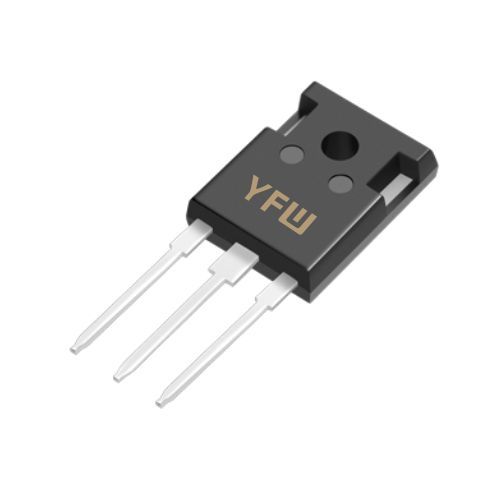Unlike traditional PN junction diodes, Schottky diodes are formed by the contact between a metal (e.g., molybdenum or aluminum) and an N-type semiconductor (usually silicon). This interface creates a Schottky barrier, a potential difference that controls current flow. When forward-biased, electrons from the semiconductor easily cross the barrier into the metal, resulting in a low forward voltage drop (typically 0.3–0.6V). This mechanism relies on majority carriers (electrons), eliminating the minority carrier storage effect found in PN diodes. Consequently, Schottky diodes exhibit ultra-fast switching speeds, with reverse recovery times as low as a few nanoseconds.
The metal-semiconductor junction’s structure also influences their electrical behavior. For instance, the Schottky barrier height determines the diode’s forward voltage and reverse leakage current. In YFW’s products like the MBR40200PTS (200V, 20A), the optimized barrier design ensures a balance between low VF (0.73V) and high surge current capability (450A).
Schottky diodes’ most advantage is their low forward voltage drop, which minimizes power dissipation. For example, YFW’s 1N5819W (40V, 1A) achieves a VF of just 370mV at 10mA. This efficiency is critical in battery-powered devices and high-current applications like switch-mode power supplies (SMPS), where even a 0.1V reduction in VF can translate to significant energy savings.
Their absence of minority carrier storage allows Schottky diodes to operate efficiently at frequencies up to 100GHz. This makes them ideal for RF circuits, inverters, and high-speed switching applications. YFW’s surface-mount SK58, designed for compact electronics, exemplifies this with its low junction capacitance (6pF at 1MHz) and fast response.
Unlike conventional diodes, Schottky diodes generate minimal reverse recovery current, reducing switching losses and electromagnetic interference (EMI). This feature is vital in automotive electronics and renewable energy systems, where high-frequency operation demands precision.
Schottky diodes typically have lower reverse voltage capabilities compared to PN diodes. While YFW’s MBR40200PTS reaches 200V, most silicon-based Schottky diodes top out at 100–200V. For higher voltages (e.g., 600V+), PIN diodes or SiC-based Schottky diodes are preferred.
Reverse leakage current increases exponentially with temperature. For example, YFW’s MBR3060PTS (60V, 30A) specifies a maximum IR of 50μA at 25°C, which rises with temperature. This necessitates robust thermal management in high-temperature environments like industrial motors or automotive engines.
Schottky diodes using silicon carbide (SiC) offer superior performance (e.g., higher voltage tolerance and lower losses) but come at a premium. While YFW’s current lineup focuses on silicon-based solutions, SiC technology is a growing trend in high-power applications.
Switch-Mode Power Supplies (SMPS): Schottky diodes like YFW’s SS36 (60V, 3A) enable efficient rectification in chargers and adapters, where low VF (700mV) reduces heat generation.
Inverters and Converters: Their fast switching speeds enhance the efficiency of renewable energy systems, such as solar inverters.
Battery Management: Schottky diodes protect circuits from reverse polarity and voltage spikes in automotive ECUs.
Motor Control: YFW’s TO-247S-packaged diodes (e.g., MBR40200PTS) handle high currents in electric vehicle (EV) drivetrains.
High-Frequency Communication: Schottky diodes are used in RF detectors and mixers for 5G infrastructure.
Medical Equipment: Their reliability is critical in devices like MRI machines and portable defibrillators.
YFW’s Schottky diodes are engineered to meet rigorous standards, with features like:
Wide Temperature Range: Operating from -55°C to +150°C (e.g., MBR3060PTS).
RoHS Compliance: Ensuring environmental safety in all products.
Custom Solutions: Tailored designs for niche applications, from aerospace to IoT.
By combining innovative materials and precision manufacturing, YFW delivers Schottky diodes that balance performance, reliability, and cost-effectiveness.
Schottky diodes have revolutionized modern electronics with their low forward voltage, high-speed switching, and versatility. While they face limitations in reverse voltage and temperature sensitivity, advancements in materials (e.g., SiC) and design continue to expand their applications. As a trusted manufacturer, YFW empowers engineers worldwide with cutting-edge Schottky diodes that drive efficiency and innovation across industries. Whether in consumer gadgets or industrial power systems, Schottky diodes remain a cornerstone of modern circuit design.
